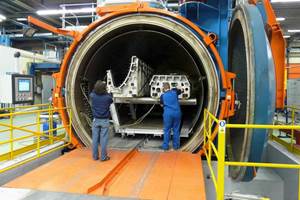Fabrication methods
The most basic fabrication method for thermoset composites is hand layup, which typically consists of laying dry plies or prepreg plies by hand onto a tool to form a laminate stack. Resin is applied to the dry plies after layup is complete (e.g., by means of resin infusion) or, in a variation known as wet layup, each
The most basic fabrication method for thermoset composites is hand layup, which typically consists of laying dry plies or prepreg plies by hand onto a tool to form a laminate stack. Resin is applied to the dry plies after layup is complete (e.g., by means of resin infusion) or, in a variation known as wet layup, each ply is coated with resin and "debulked"or compacted after it is placed.
Several curing methods are available. The most basic is simply to allow cure to occur at room temperature. Cure can be accelerated, however, by applying heat, typically with an oven, and pressure, by means of vacuum. For the latter, a vacuum bag, with breather assemblies, is placed over the layup and attached to the tool, then evacuated before cure. The vacuum bagging process consolidates the plies of material and significantly reduces voids due to off-gassing that occurs as the matrix progresses through its chemical curing stages.
Many high-performance thermoset parts require both heat and high consolidation pressure to cure, conditions that require the use of an autoclave. Autoclaves, generally, are expensive to buy and operate. Manufacturers equipped with autoclaves usually cure a number of parts simultaneously. Computer systems monitor and control autoclave temperatures, pressure, vacuum and inert atmosphere, which allows unattended and/or remote supervision of the cure process and maximizes efficient use of the technique.
When heat is required for cure, the part temperature is "ramped up"in small increments, maintained at cure level for a specified period of time, then "ramped down"to room temperature, to avoid part distortion or warp caused by uneven expansion and contraction. When this curing cycle is complete and after parts are demolded, some parts go through a secondary freestanding postcure, during which they are subjected for a specific period of time to a temperature higher than that of the initial cure, to enhance crosslink density.
Electron-beam (E-beam) curing holds promise as an efficient curing method for thin laminates. In E-beam curing, the composite layup is exposed to a stream of electrons that provide ionizing radiation, causing polymerization and crosslinking in radiation-sensitive resins. X-ray and microwave curing technologies work in a similar manner. A fourth alternative, ultraviolet (UV) curing, involves the use of UV radiation to activate a photoinitiator added to a thermoset resin, which, when activated, sets off a crosslinking reaction. UV curing requires light-permeable resin and reinforcements.
An emerging technology is the monitoring of the cure itself. Dielectric cure monitors measure the extent of cure by gauging the conductivity of ions - small, polarized, relatively insignificant impurities resident in resins. Ions tend to migrate toward an electrode of opposite polarity, but the speed of migration is limited by the viscosity of the resin - the higher the viscosity, the slower the speed. As crosslinking proceeds during cure, resin viscosity increases. Other methods include dipole monitoring within the resin, the monitoring of micro-voltage produced by the crosslinking, monitoring of the exothermic reaction in the polymer during cure and, potentially, the use of infrared monitoring via fiber-optic technology.
Related Content
Plataine unveils AI-based autoclave scheduling optimization tool
The Autoclave Scheduler is designed to increase autoclave throughput, save operational costs and energy, and contribute to sustainable composite manufacturing.
Read MoreIndustrial composite autoclaves feature advanced control, turnkey options
CAMX 2024: Designed and built with safety and durability in mind, Akarmark delivers complete curing autoclave systems for a variety of applications.
Read MoreBusch expands autoclave solutions
Busch announces its ability to address all autoclave, oven and associated composites manufacturing requirements following the acquisition of Vacuum Furnace Engineering.
Read MoreIndustrial curing autoclaves with advanced control systems
CAMX 2025: Turnkey Akarmak autoclaves support various composite curing needs with enhanced process control, international specification compliance and optimal heat distribution.
Read MoreRead Next
Cutting 100 pounds, certification time for the X-59 nose cone
Swift Engineering used HyperX software to remove 100 pounds from 38-foot graphite/epoxy cored nose cone for X-59 supersonic aircraft.
Read MoreScaling up, optimizing the flax fiber composite camper
Greenlander’s Sherpa RV cab, which is largely constructed from flax fiber/bio-epoxy sandwich panels, nears commercial production readiness and next-generation scale-up.
Read MoreCeramic matrix composites: Faster, cheaper, higher temperature
New players proliferate, increasing CMC materials and manufacturing capacity, novel processes and automation to meet demand for higher part volumes and performance.
Read More








